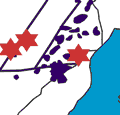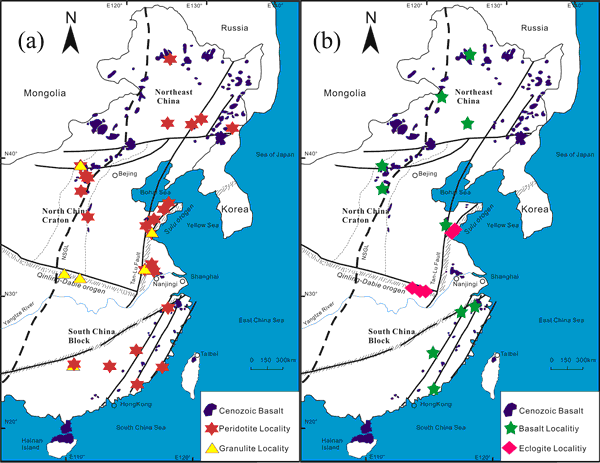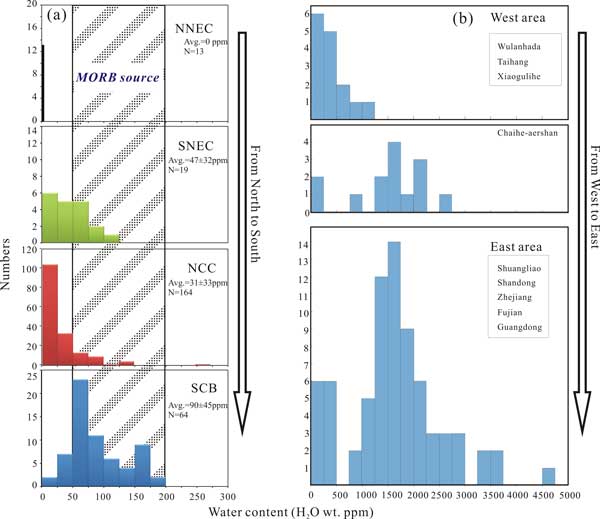 |
Water in the upper mantle and deep crust of eastern China: concentration, distribution and implications |
Qun-Ke Xia1, Jia Liu2, István Kovács3, Yan-Tao Hao1, Pei Li1, Xiao-Zhi Yang4, Huan Chen2, Yin-Min Sheng2
1School of Earth Sciences, Zhejiang University, Hangzhou, 310027 China; qkxia@zju.edu.cn; peili@zju.edu.cn
2CAS Key Laboratory of Crust-Mantle Materials and Environments, University of Science and Technology of China, Hefei, 230026 China; liujia08@ustc.edu.cn; rainbow1@mail.ustc.edu.cn
3Hungarian Geological and Geophysical Institute, Stefánia street 14, Budapest, 1143, Hungary; kovacs.istvan.janos@mfgi.hu
4School of Earth Sciences and Engineering, Nanjing University, Nanjing, China; xzyang@nju.edu.cn
This webpage is a summary of Qun-Ke Xia, Jia Liu, István Kovács, Yan-Tao Hao, Pei Li, Xiao-Zhi Yang, Huan Chen & Yin-Min Sheng, Water in the upper mantle and deep crust of eastern China: concentration, distribution and implications, National Science Review, 2017, https://doi.org/10.1093/nsr/nwx016.
Introduction
The concentration and distribution of water in the Earth’s interior plays a substantial role in its chemical, physical and dynamic processes. The concentration and distribution of water in the deep lithosphere (lower crust and lithospheric mantle) and upper mantle can be determined from natural samples, including mafic granulites, peridotites, pyroxenites, eclogites and basalts. Information about the mantle transition zone and lower mantle is mostly obtained by high temperature and pressure experiments.
After a decade of research a comprehensive dataset has now been built of the water content in peridotite and granulite xenoliths hosted by alkali basalts, terrain granulites, ultrahigh pressure metamorphic (UHPM) eclogites, and Mesozoic-Cenozoic alkali basalts from eastern China. This is now the only region for which there is water-content data from such diverse natural samples (Figure 1). This dataset provides an integrated picture of the water content and its distribution in the lower crust and upper mantle on a continental scale.

Figure 1: Sample locations in eastern China. (a) Peridotite and granulite locations; (b) Basalt and eclogite locations. Click here or on Figure for enlargement.
Main findings
-
Although the main minerals in the lithospheric mantle of eastern China are nominally anhydrous (olivine, cpx, opx, etc.), they usually contain a certain amount of water–up to several hundreds of ppm–as hydroxyl groups in their structural defects (Aubaud et al., 2007; Yang et al., 2018b; Xia et al., 2010, 2013a; Yu et al., 2011; Hao et al., 2012, 2014, 2016a, b; Liu & Xia, 2014; Wang et al., 2014; Li et al., 2015; Tian et al., 2017). The temporal variation of the water content in the lithospheric mantle from the early Cretaceous (~120 Ma) to the Cenozoic (<40 Ma) appears closely connected to the stability of the North China Craton (NCC) from its destruction to its consolidation. This provides a clear case showing that the rheological changes induced by water in the lithospheric mantle affect the stability of continents (Xia et al., 2013b; Li et al., 2015).
-
The heterogeneous water content in the Cenozoic lithospheric mantle beneath different blocks of eastern China was not only inherited from the tectonic settings from which they came before having been amalgamated into a single continent, but was also affected by later geological processes (Hao et al., 2016a).
-
The distinct water content between the lowermost crust and lithospheric mantle of eastern China and the resulting rheological contrast at the base of the crust indicate that the continental crust-mantle boundary could behave either in a coupled or decoupled style beneath different areas and/or at different stages (Yang et al., 2008b).
-
The water contrast between the Precambrian and Phanerozoic lower crust of eastern China suggests temporal evolution of the water content of the Earth’s crust, different formation mechanisms of the continental lower crust, or both (Xia et al., 2006; Yang et al., 2008a). It is likely that the continental lower crust became gradually depleted of water over geologic time, contributing to the stronger rheology and, therefore, preservation of the continental crust.
-
The alkali basalts of eastern China demonstrate a heterogeneous distribution of the water content in the upper mantle and MTZ (Chen et al., 2015a, b, 2017; Liu J et al., 2015a, b; Liu S et al., 2016). Pacific plate subduction is likely the main process introducing heterogeneities in the water content and other geochemical characteristics of intra-plate magmas. Local and regional comparisons of the water content between the lithospheric mantle and basalt source (Figure 2) demonstrate that the Cenozoic alkali basalts of eastern China were not sourced from the lithospheric mantle. Instead, the inferred high water contents in the mantle sources indicate that Cenozoic eastern China basalts were likely sourced from the MTZ.
-
The UHPM eclogites of the Dabie-Sulu orogeny can host up to thousands of ppm of water in nominally anhydrous garnets and omphacites, demonstrating that the “dry” continental crust may carry a certain amount of water back into the deep mantle by subduction (Zhang et al., 2001; Xia et al., 2005; Su et al., 2005; Zhang et al., 2006; Sheng et al., 2007; Chen et al., 2007; Gong et al., 2007; Zhao & Zhang, 2007; Zhao et al., 2007; Meng et al., 2009; Guo et al., 2012). Such recycled continental crustal materials not only created a local water-rich zone, but also delivered continental geochemical signatures into the mantle. These effects account for the continental geochemical imprints in some OIBs and other intra-plate basalts.
Future Issues
-
More data from other areas are necessary to test the conclusions drawn from the data from eastern China, such as higher water content in the lower crust than the underlying lithospheric mantle, and more hydrous Precambrian lower crust than its Phanerozoic counterpart. In addition, the spatial and temporal distribution of the water content in the lithospheric mantle and its effect on continental evolution also require further exploration by collecting more data from other parts of the world.

Figure 2: Water content in the Cenozoic lithospheric mantle (a) and the Cenozoic basalt source (b) of eastern China. Note (1) The basalt source displays much higher water content than the lithospheric mantle, (2) The water content in the Cenozoic lithospheric mantle increases from north to south whereas that in the basalt source increases from west to east. Click here or on Figure for enlargement.
-
Pyroxenites are an important constituent of the upper mantle and are likely the source lithology of some intra-plate basalts. In particular, local enrichment of Fe- and H-bearing pyroxenites may lead to regional electrical anomalies that affect the structure and some key properties of the upper mantle. However, less attention has been paid to water in pyroxenites, and so far only Bizmis & Peslier (2015) have reported water in 6 pyroxenite xenoliths with similar genesis (crystallized from basaltic magmas) from Hawaiian basalts. Due to the prominent role of water in the temperature, pressure, degree of melting, and composition of melts, it is necessary to study systematically water in pyroxenites in different tectonic settings.
-
Felsic rocks are the main constituents in UHPM orogens and the dominant assemblages in the shallower crust. The content and partitioning of water in minerals of felsic rocks should be investigated to gain a more comprehensive understanding of the recycling of water during the subduction and exhumation of continental plates, the storage of water in the crust, and its exchange between different reservoirs.
-
Magma water contents provide new constraints on important issues related to the production of intra-plate continental basalts, such as the nature of mantle sources (lithosphere vs. asthenosphere) and origin of enriched components. Current work relies on the established cpx-phenocryst-based approach. The uncertainty of this method is relatively large and it cannot be applied to basalts free of cpx phenocrysts. Thus, in the future, a new methodology with better accuracy and wider applicability should be developed.
-
The partition coefficient of water between opx and cpx in peridotites is variable. This variation should be studied further to understand its origin and whether there is any relationship with geochemical and physical variables.
Acknowledgements
Financial support was provided by National Science Foundation of China (No. 41225005).
References
-
Aubaud, C., Withers, A. C., Hirschmann, M. M., et al. Intercalibration of FTIR and SIMS for hydrogen measurements in glasses and nominally anhydrous minerals. Am. Mineral. 92: 811-828 (2007).
-
Bizimis, M., & Peslier, A. H. Water in Hawaiian garnet pyroxenites: Implications for water heterogeneity in the mantle. Chem. Geol. 397: 61-75 (2015).
-
Chen, H., Xia, Q. K., Ingrin, J. Water content of the Xiaogulihe ultrapotassic volcanic rocks, NE China: implications for the source of the potassium-rich component. Sci Bull. 60: 1468-1470 (2015a).
-
-
-
-
Gong, B., Zheng, Y. F., Chen, R. X. A TC/EA–MS online method for determination of hydrogen isotope composition and water concentration in geological samples. Rapid Commun. Mass Spectrom. 21: 1386–1392 (2007).
-
Guo, S., Ye, K., Chen, Y., et al. Fluid–rock interaction and element mobilization in UHP metabasalt: Constraints from an omphacite–epidote vein and host eclogites in the Dabie orogen. Lithos 136-139: 145-167 (2012).
-
Hao, Y. T., Xia, Q. K., Liu, S. C., et al. Recognizing juvenile and relict lithospheric mantle beneath the North China Craton: Combined analysis of H2O, major and trace elements and Sr-Nd isotope compositions of clinopyroxenes. Lithos 149: 136-145 (2012).
-
Hao, Y. T., Xia, Q. K., Li, Q. W., et al. Partial melting control of water contents in the Cenozoic lithospheric mantle of the Cathaysia block of South China. Chem. Geol. 380: 7-19 (2014).
-
Hao, Y. T., Xia, Q. K., Jia, Z. B., et al. Regional heterogeneity in the water content of the Cenozoic lithospheric mantle of Eastern China. J. Geophys. Res. Solid Earth 121: 1-21 (2016a).
-
Hao, Y. T., Xia, Q. K., Tian, Z. Z., et al. Mantle metasomatism did not modify the water content of the peridotite xenoliths from the Tianchang basalts of eastern China. Lithos 260: 315-327 (2016b).
-
Li, P., Xia, Q. K., Deloule, E., et al. Temporal variation of H2O content in the lithospheric mantle beneath the eastern North China Craton: Implications for the destruction of cratons. Gond. Res. 28: 276-287 (2015).
-
Liu, J., Xia, Q. K., Deloule, E., et al. Recycled oceanic crust and marine sediment in the source of alkali basalts in Shandong, eastern China: Evidence from magma water content and oxygen isotopes. J. Geophys. Res. Solid Earth 120: 8281-8303 (2015a).
-
Liu, J., Xia, Q. K., Deloule, E., et al. Water Content and Oxygen Isotopic Composition of Alkali Basalts from the Taihang Mountains, China: Recycled Oceanic Components in the Mantle Source. J. Petrol. 56: 681-702 (2015b).
-
Liu, S. C. & Xia, Q. K. Water content in the early Cretaceous lithospheric mantle beneath the south-central Taihang Mountains: implications for the destruction of the North China Craton. Chin. Sci. Bull. 59: 1362-1365 (2014).
-
Liu, S. C., Xia, Q. K., Choi, S. H., et al. Continuous supply of recycled Pacific oceanic materials in the source of Cenozoic basalts in SE China: the Zhejiang case. Contrib. Mineral. Petrol. 171(12): 1-31 (2016).
-
Meng, D. W., Wu, X. L., Fan, X. Y., et al. Submicron-sized fluid inclusions and distribution of hydrous components in jadeite, quartz and symplectite-forming minerals from UHP jadeite-quartzite in the Dabie Mountains, China: TEM and FTIR investigation. App. Geochem. 24: 517-526 (2009).
-
Sheng, Y. M., Xia, Q. K., Dallai, L., et al. H2O contents and D/H ratios of nominally anhydrous minerals from ultrahigh-pressure eclogites of the Dabie orogen, eastern China. Geochim. Cosmochim. Acta 71: 2079-2103 (2007).
-
Su, W., Ji, Z. P., Ye, K., et al. Distribution of hydrous components in jadeite of the Dabie Mountains. Earth Planet. Sci. Lett. 222(1): 85-100 (2005).
-
Tian, Z. Z., Liu. J., Xia, Q. K., et al. Water concentration profiles in natural mantle orthopyroxenes: A geochronometer for long annealing of xenoliths within magma. Geology 45: 87-90 (2017).
-
Wang, Q., Bagdassarov, N., Xia, Q. K., et al. Water contents and electrical conductivity of peridotite xenoliths from the North China Craton: Implications for water distribution in the upper mantle. Lithos 189: 105-126 (2014).
-
Xia, Q. K., Sheng, Y. M., Yang, X. Z., et al. Heterogeneity of water in garnets from UHP eclogites, eastern Dabieshan, China. Chem. Geol. 224: 237–246 (2005).
-
Xia, Q. K., Yang, X. Z., Deloule, E., et al. Water in the lower crustal granulite xenoliths from Nushan, eastern China. J. Geophys. Res. Solid Earth B11202, doi: 10.1029/2006JB004296 (2006).
-
-
Xia, Q. K., Hao, Y. T., Liu, S. C., et al. Water contents of the Cenozoic lithospheric mantle beneath the western part of the North China Craton: Peridotite xenolith constraints. Gond. Res. 23: 108-118 (2013a).
-
Xia, Q. K., Liu, J., Liu, S. C., et al. High water content in Mesozoic primitive basalts of the North China Craton and implications on the destruction of cratonic mantle lithosphere. Earth Planet. Sci. Lett. 361: 85-97 (2013b).
-
Yang, X. Z., Deloule, E., Xia, Q. K., et al. Water contrast between Precambrian and Phanerozoic continental lower crust in eastern China. J. Geophys. Res. Solid Earth 113, B08207, doi: 08210.01029/02007JB005541 (2008a).
-
Yang, X. Z., Xia, Q. K., Deloule, E., et al. Water in minerals of continental lithospheric mantle and overlying lower crust: a comparative study of peridotite and granulite xenoliths from the North China Craton. Chem. Geol. 256: 33-45 (2008b).
-
Yu, Y., Xu, X. S., Griffin, W. L., et al. H2O contents and their modification in the Cenozoic subcontinental lithospheric mantle beneath the Cathaysia block, SE China. Lithos 126: 182-197 (2011).
-
Zhang, J. F., Jin, Z. M., Green, H. W., et al. Hydroxyl in continental deep subduction zone: Evidence from UHP eclogites of the Dabie Mountains. Chin. Sci. Bull. 46: 592-596 (2001).
-
-
Zhao, X. D., & Zhang, Z. M. Water in omphacites from UHP eclogites in the CCSD main hole. Acta Petrol. Sin. 22: 2039-2050 (2007).
-
Zhao, Z. F., Chen, B., Zheng, Y. F., et al. Mineral oxygen isotope and hydroxyl content changes in ultrahigh-pressure eclogite-gneiss contacts from Chinese Continental Scientific Drilling Project cores. J. Metamorph. Geol. 25: 165-186 (2007).
last updated 10th October, 2017 |
